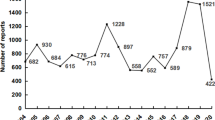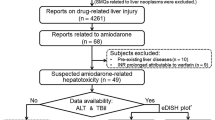Abstract
Background While tetracycline antibiotics are commonly prescribed in practice, the risk of drug-induced liver injury (DILI) remains controversial. Aim To evaluate the association of DILI with tetracycline antibiotics. Method All DILI cases of tetracycline antibiotics as primary suspected drugs were extracted from the US Food and Drug Administration adverse event reporting system (FAERS). The outcomes included severe DILI, hepatocellular injury, cholestatic injury, and liver failure. Disproportionality analyses were conducted by estimating the reporting odds ratio (ROR) and the information component (IC). Results A total of 1,435 liver injury cases associated with tetracycline antibiotics were identified. The DILI signal was detected in tigecycline, minocycline, and doxycycline. The RORs and the 95% confidence intervals (95% CI) of tigecycline, minocycline, and doxycycline were (ROR 5.85, 95% CI 4.96–6.91), (ROR 6.4, 95% CI 5.76–7.11), and (ROR 2.07, 95% CI 1.86–2.31), respectively. Compared to minocycline (ROR 5.5, 95% CI 4.94–6.12; IC 2.35, 95% CI 1.98–2.68) and doxycycline (ROR 1.91, 95% CI 1.71–2.12; IC 0.91, 95% CI 0.55–1.26), tigecycline showed a stronger association with hepatocellular injury (ROR 7.11, 95% CI 6.13–8.23; IC 2.68, 95% CI 2.16–3.13). Tigecycline also showed a stronger association with cholestatic injury (ROR 12.16, 95% CI 10.13–14.61; IC 3.51, 95% CI 2.79–4) than minocycline (ROR 3.23, 95% CI 2.59–4.04; IC 1.67, 95% CI 0.9–2.37) or doxycycline (ROR 2.86, 95% CI 2.47–3.31; IC 1.5, 95% CI 1–1.97). Tigecycline (ROR 6.56, 95% CI 4.57–9.41; IC 2.69, 95% CI 1.28–3.64) and minocycline (ROR 4.22, 95% CI 3.14–5.66; IC 2.06, 95% CI 1–2.93) showed a significant association with liver failure. Conclusion The data mining of FAERS suggested an association between DILI and tigecycline, minocycline, and doxycycline.

Similar content being viewed by others
References
Leise M, Poterucha JJ, Talwalkar JA. Drug-induced liver injury. Mayo Clin Proc. 2014;89(1):95–106.
Sgro C, Clinard F, Ouazir K, et al. Incidence of drug-induced hepatic injuries: a French population-based study. Hepatology. 2002;36(2):451–5.
Björnsson ES, Bergmann OM, Björnsson HK, et al. Incidence, presentation, and outcomes in patients with drug-induced liver injury in the general population of Iceland. Gastroenterology. 2013;144(7):1419–25 (25.e1-3; quiz e19-20).
Shen T, Liu Y, Shang J, et al. Incidence and etiology of drug-induced liver injury in mainland China. Gastroenterology. 2019;156(8):2230-41.e11.
Björnsson ES. Hepatotoxicity by drugs: the most common implicated agents. Int J Mol Sci. 2016;17(2):224.
Chalasani N, Bonkovsky HL, Fontana R, et al. Features and outcomes of 899 patients with drug-induced liver injury: the DILIN prospective study. Gastroenterology. 2015;148(7):1340-52.e7.
Yin YD, Wang R, Zhuo C, et al. Macrolide-resistant Mycoplasma pneumoniae prevalence and clinical aspects in adult patients with community-acquired pneumonia in China: a prospective multicenter surveillance study. J Thorac Dis. 2017;9(10):3774–81.
Chen J, Qi X, Yin Y, et al. Effects of minocycline on macrolide-unresponsive Mycoplasma pneumoniae pneumonia in children: a single-center retrospective study. Transl Pediatr. 2021;10(11):2997–3004.
Lee H, Choi YY, Sohn YJ, et al. Clinical efficacy of doxycycline for treatment of macrolide-resistant Mycoplasma pneumoniae pneumonia in children. Antibiotics (Basel). 2021;10(2):192.
Zaenglein AL, Shamban A, Webster G, et al. A phase IV, open-label study evaluating the use of triple-combination therapy with minocycline HCl extended-release tablets, a topical antibiotic/retinoid preparation and benzoyl peroxide in patients with moderate to severe acne vulgaris. J Drugs Dermatol. 2013;12(6):619–25.
Bienenfeld A, Nagler AR, Orlow SJ. Oral antibacterial therapy for acne vulgaris: an evidence-based review. Am J Clin Dermatol. 2017;18(4):469–90.
Eichenfield DZ, Sprague J, Eichenfield LF. Management of acne vulgaris: a review. JAMA-J Am Med Assoc. 2021;326(20):2055–67.
Stultz JS, Eiland LS. Doxycycline and tooth discoloration in children: changing of recommendations based on evidence of safety. Ann Pharmacother. 2019;53(11):1162–6.
Zhanel GG, Homenuik K, Nichol K, et al. The glycylcyclines: a comparative review with the tetracyclines. Drugs. 2004;64(1):63.
Karakonstantis S, Kritsotakis EI, Gikas A. Treatment options for K. pneumoniae, P. aeruginosa and A. baumannii co-resistant to carbapenems, aminoglycosides, polymyxins and tigecycline: an approach based on the mechanisms of resistance to carbapenems. Infection. 2020;48(6):835–51.
Mei H, Yang T, Wang J, et al. Efficacy and safety of tigecycline in treatment of pneumonia caused by MDR Acinetobacter baumannii: a systematic review and meta-analysis. J Antimicrob Chemoth. 2019;74(12):3423–31.
Wilcox MH. Tigecycline and the need for a new broad-spectrum antibiotic class. Surg Infect. 2006;7(1):69–80.
Esposito S, Petta E. Tigecycline for treatment of intra-abdominal infections: a literature update. J Chemother. 2009;21(Supplement-1):56–60.
Leng B, Yan G, Wang C, et al. Dose optimization based on pharmacokinetic/pharmacodynamic target of tigecycline. J Glob Antimicrob Resist. 2021;25(Suppl 1):315–22.
Han H, Qin W, Zheng Y, et al. High-dose versus standard-dose tigecycline treatment of secondary bloodstream infections caused by extensively drug-resistant Acinetobacter baumannii: an observational cohort study. Infect Drug Resist. 2021;14:3837–48.
Lebrun-Vignes B, Kreft-Jais C, Castot A, et al. Comparative analysis of adverse drug reactions to tetracyclines: results of a French national survey and review of the literature. Brit J Dermatol. 2012;166(6):1333–41.
Smith K, Leyden JJ. Safety of doxycycline and minocycline: a systematic review. Clin Ther. 2005;27(9):1329–42.
Bettesda(MD). Liver Tox: Clinical and research information on drug-induced liver injury. PubMed. 2019; https://www.ncbi.nlm.nih.gov/books/NBK548040/. Last update: 10 April 2019.
Allen ES, Brown WE. Hepatic toxicity of tetracycline in pregnancy. Am J Obstet Gynecol. 1966;95(1):12–8.
Peters RL, Edmondson HA, Mikkelsen WP, et al. Tetracycline-induced fatty liver in nonpregnant patients. A report of six cases. Am J Surg. 1967;113(5):622–32.
Chen Z, Shi X. Adverse events of high-dose tigecycline in the treatment of ventilator-associated pneumonia due to multidrug-resistant pathogens. Medicine (Baltimore). 2018;97(38):e12467.
Björnsson E, Jerlstad P, Bergqvist A, et al. Fulminant drug-induced hepatic failure leading to death or liver transplantation in Sweden. Scand J Gastroenterol. 2005;40(9):1095–101.
Heaton PC, Fenwick SR, Brewer DE. Association between tetracycline or doxycycline and hepatotoxicity: a population based case-control study. J Clin Pharm Ther. 2007;32(5):483–7.
Sheu CC, Chang YT, Lin SY, et al. Infections caused by Carbapenem-resistant enterobacteriaceae: an update on therapeutic options. Front Microbiol. 2019;10:80.
Chatterjee S, Annaert P. Drug-induced cholestasis: mechanisms, models, and markers. Curr Drug Metab. 2018;19(10):808–18.
Evans SJ, Waller PC, Davis S. Use of proportional reporting ratios (PRRs) for signal generation from spontaneous adverse drug reaction reports. Pharmacoepidemiol Drug Saf. 2001;10(6):483–6.
Bate A, Lindquist M, Edwards IR, et al. A Bayesian neural network method for adverse drug reaction signal generation. Eur J Clin Pharmacol. 1998;54(4):315–21.
Duggirala HJ, Tonning JM, Smith E, et al. Use of data mining at the Food and Drug Administration. J Am Med Inform Assn. 2016;23(2):428–34.
FDA. FDA adverse event reporting system (FAERS) quarterly data extract files. 2021; https://fis.fda.gov/extensions/FPD-QDE-FAERS/FPD-QDE-FAERS.html. Accessed 29 Jan 2021.
Bin WU, Feng-Bo WU, Luo M, et al. Application of MedEx in FAERS drug names standardization. China J Hosp Pharm. 2019;39:1989–92.
Xu H, Stenner SP, Doan S, et al. MedEx: a medication information extraction system for clinical narratives. J Am Med Inform Assoc. 2010;17(1):19–24.
Suzuki A, Yuen NA, Ilic K, et al. Comedications alter drug-induced liver injury reporting frequency: data mining in the WHO VigiBase™. Regul Toxicol Pharmacol. 2015;72(3):481–90.
Hunt CM, Yuen NA, Stirnadel-Farrant HA, et al. Age-related differences in reporting of drug-associated liver injury: data-mining of WHO Safety Report Database. Regul Toxicol Pharmacol. 2014;70(2):519–26.
Dowling HF, Lepper MH. Hepatic reactions to tetracycline. JAMA-J Am Med Assoc. 1964;188:307–9.
Schultz JC, Adamson JS Jr, Workman WW, et al. Fatal liver disease after intravenous administration of tetracycline in high dosage. New Engl J Med. 1963;269:999–1004.
Lawrenson RA, Seaman HE, Sundström A, et al. Liver damage associated with minocycline use in acne: a systematic review of the published literature and pharmacovigilance data. Drug Saf. 2000;23(4):333–49.
Nietsch HH, Libman BS, Pansze TW, et al. Minocycline-induced hepatitis. Am J Gastroenterol. 2000;95(10):2993–5.
Rubinstein E, Vaughan D. Tigecycline: a novel glycylcycline. Drugs. 2005;65(10):1317–36.
Sacchidanand S, Penn RL, Embil JM, et al. Efficacy and safety of tigecycline monotherapy compared with vancomycin plus aztreonam in patients with complicated skin and skin structure infections: Results from a phase 3, randomized, double-blind trial. Int J Infect Dis. 2005;9(5):251–61.
Tasina E, Haidich AB, Kokkali S, et al. Efficacy and safety of tigecycline for the treatment of infectious diseases: a meta-analysis. Lancet Infect Dis. 2011;11(11):834–44.
Kadoyama K, Sakaeda T, Tamon A, et al. Adverse event profile of tigecycline: data mining of the public version of the U.S. Food and Drug Administration adverse event reporting system. Biol Pharm Bull. 2012;35(6):967–70.
Borsuk-De Moor A, Rypulak E, Potręć B, et al. Population pharmacokinetics of high-dose tigecycline in patients with sepsis or septic shock. Antimicrob Agents Chemother. 2018;62(4):e02273-e2317.
Zha L, Pan L, Guo J, et al. Effectiveness and safety of high dose tigecycline for the treatment of severe infections: a systematic review and meta-analysis. Adv Ther. 2020;37(3):1049–64.
Acknowledgements
None.
Funding
The authors thank the National Key Research and Development Program (2020YFC2008302) for providing the financial support.
Author information
Authors and Affiliations
Corresponding author
Ethics declarations
Conflicts of interests
Authors declare no conflicts of interests.
Additional information
Publisher's Note
Springer Nature remains neutral with regard to jurisdictional claims in published maps and institutional affiliations.
Supplementary Information
Below is the link to the electronic supplementary material.
Rights and permissions
About this article
Cite this article
Wei, C., Liu, Y., Jiang, A. et al. A pharmacovigilance study of the association between tetracyclines and hepatotoxicity based on Food and Drug Administration adverse event reporting system data. Int J Clin Pharm 44, 709–716 (2022). https://doi.org/10.1007/s11096-022-01397-5
Received:
Accepted:
Published:
Issue Date:
DOI: https://doi.org/10.1007/s11096-022-01397-5




